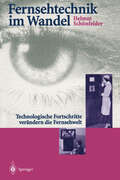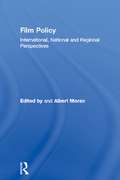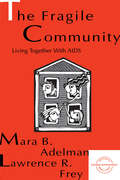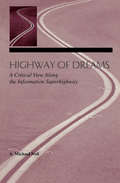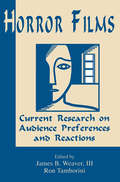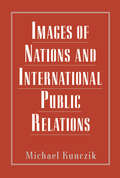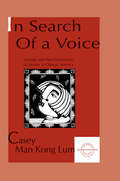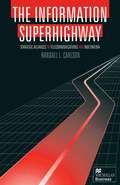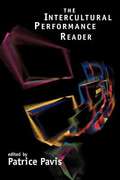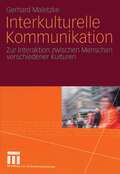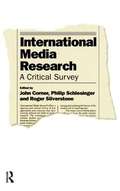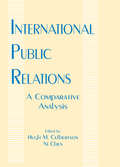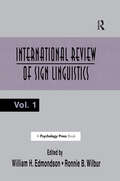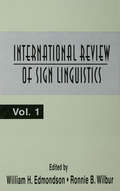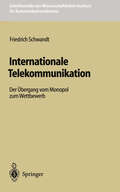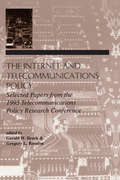- Table View
- List View
Fernsehtechnik im Wandel: Technologische Fortschritte verändern die Fernsehwelt (Edition Alcatel SEL Stiftung)
by Helmut SchönfelderBreitgefächerter Überblick von den mechanischen Anfängen des Fernsehens bis zur datenreduzierten digitalen Fernsehübertragung. Mit vielen farbigen Schirmbildaufnahmen veranschaulicht.
Film Policy: International, National and Regional Perspectives
by Albert MoranFilm Policy is the first comprehensive overview of the workings of the international film industry. The authors examine film cultures and film policy across the world, explaining why Hollywood cinema dominates the global film market, and the effects of the rise of television and video on the international industry. In a series of case studies drawn from North America, Europe, Latin America, Asia and Australia, the authors explore the relationship between Hollywood cinema product and national film cultures, and trace the development of international and national film policies, looking at issues of financing, regulation, protectionism and censorship.
Film Policy: International, National and Regional Perspectives
by Albert MoranFilm Policy is the first comprehensive overview of the workings of the international film industry. The authors examine film cultures and film policy across the world, explaining why Hollywood cinema dominates the global film market, and the effects of the rise of television and video on the international industry. In a series of case studies drawn from North America, Europe, Latin America, Asia and Australia, the authors explore the relationship between Hollywood cinema product and national film cultures, and trace the development of international and national film policies, looking at issues of financing, regulation, protectionism and censorship.
The Fragile Community: Living Together With Aids
by Mara B. Adelman Larry R. FreyThis book examines the concept of "community," focusing on how communication practices help manage the tensions of creating and sustaining everyday communal life amidst the crisis of human loss. While acknowledging how the contradictory and inconsistent nature of human relationships inevitably affects community, this intimate and compelling text shows how community is created and sustained in concrete communication practices. The authors explore these ideas at Bonaventure House, an award-winning residential facility for people with AIDS, where the web of social relationships and the demands of a life-threatening illness intersect in complex ways. Facing a life-threatening illness can defy meaningful social connections, but it can also inspire such ties, sometimes in ways that elude us in the course of daily life. By understanding how collective communication practices help residents forge a sense of community out of the fragility and chaos of living together with AIDS, we are able to better understand how communication is inexorably intertwined with the formation of community in other environments. Based on seven years of ethnographic research including participant-observation, in-depth interviews, and questionnaires, this book weaves together narratives and visual images with conceptual analysis to uncover the ongoing oppositional forces of community life, and to show how both mundane and profound communication processes ameliorate these tensions, and thereby sustain this fragile community. Because the average length of stay for a resident is seven months -- in which time he or she moves from being a newcomer to a community member to someone the community remembers -- the text reflects this short, but crystallized life, starting with the day a new resident opens the door to the day he or she passes away. The writing is rich -- intimate, engaging, personal, compelling, and vivid. The stories told discuss such deeply personal topics as the dilemmas of romantic relationships in a context fraught with many perils; issues of power, authority, and control that enable and constrain social life; and communicative practices that help residents cope with bereavement over the loss of others as well as their own impending deaths. The text concludes by examining the lessons learned from Bonaventure House about creating and sustaining a health community, and serves as an inspiration for strengthening interpersonal relationships and communities in other environments.
The Fragile Community: Living Together With Aids (Everyday Communication Ser.)
by Mara B. Adelman Larry R. FreyThis book examines the concept of "community," focusing on how communication practices help manage the tensions of creating and sustaining everyday communal life amidst the crisis of human loss. While acknowledging how the contradictory and inconsistent nature of human relationships inevitably affects community, this intimate and compelling text shows how community is created and sustained in concrete communication practices. The authors explore these ideas at Bonaventure House, an award-winning residential facility for people with AIDS, where the web of social relationships and the demands of a life-threatening illness intersect in complex ways. Facing a life-threatening illness can defy meaningful social connections, but it can also inspire such ties, sometimes in ways that elude us in the course of daily life. By understanding how collective communication practices help residents forge a sense of community out of the fragility and chaos of living together with AIDS, we are able to better understand how communication is inexorably intertwined with the formation of community in other environments. Based on seven years of ethnographic research including participant-observation, in-depth interviews, and questionnaires, this book weaves together narratives and visual images with conceptual analysis to uncover the ongoing oppositional forces of community life, and to show how both mundane and profound communication processes ameliorate these tensions, and thereby sustain this fragile community. Because the average length of stay for a resident is seven months -- in which time he or she moves from being a newcomer to a community member to someone the community remembers -- the text reflects this short, but crystallized life, starting with the day a new resident opens the door to the day he or she passes away. The writing is rich -- intimate, engaging, personal, compelling, and vivid. The stories told discuss such deeply personal topics as the dilemmas of romantic relationships in a context fraught with many perils; issues of power, authority, and control that enable and constrain social life; and communicative practices that help residents cope with bereavement over the loss of others as well as their own impending deaths. The text concludes by examining the lessons learned from Bonaventure House about creating and sustaining a health community, and serves as an inspiration for strengthening interpersonal relationships and communities in other environments.
Highway of Dreams: A Critical View Along the Information Superhighway (LEA Telecommunications Series)
by A. Michael NollThis important volume reviews the history of the telecommunication superhighway pointing out its beginnings in the interactive TV and broadband highway of the wired cities more than two decades ago. It explains the technological uncertainties of the superhighway and many of its futuristic services, and also gives an understandable review of the technological principles behind today's modern telecommunication networks and systems. Recognizing that technology is only one factor in shaping the future, the author, a well-recognized telecommunications expert, analyzes the financial, policy, business, and consumer issues that undermine the superhighway. The book concludes by showing that today's switched telephone network and CATV systems already form a telecommunication superhighway carrying voice, data, image, and video communication for a wide variety of services that enable us to stay in contact with anyone anywhere on our planet. Highway of Dreams is written clearly with understandable explanations for nonspecialists. It challenges the technological utopia offered by the promoters of the superhighway and suggests that consumer needs, finance, corporate culture, and policy often have far greater impact on the future than technology alone.
Highway of Dreams: A Critical View Along the Information Superhighway (LEA Telecommunications Series)
by A. Michael NollThis important volume reviews the history of the telecommunication superhighway pointing out its beginnings in the interactive TV and broadband highway of the wired cities more than two decades ago. It explains the technological uncertainties of the superhighway and many of its futuristic services, and also gives an understandable review of the technological principles behind today's modern telecommunication networks and systems. Recognizing that technology is only one factor in shaping the future, the author, a well-recognized telecommunications expert, analyzes the financial, policy, business, and consumer issues that undermine the superhighway. The book concludes by showing that today's switched telephone network and CATV systems already form a telecommunication superhighway carrying voice, data, image, and video communication for a wide variety of services that enable us to stay in contact with anyone anywhere on our planet. Highway of Dreams is written clearly with understandable explanations for nonspecialists. It challenges the technological utopia offered by the promoters of the superhighway and suggests that consumer needs, finance, corporate culture, and policy often have far greater impact on the future than technology alone.
Horror Films: Current Research on Audience Preferences and Reactions (Routledge Communication Series)
by Ron Tamborini James B. WeaverWhy do so many of us enjoy being told frightening stories? What are some of the consequences that result from such exposure? In light of the considerable popularity of horror films over the last three decades, these questions have become the focus of growing attention for many scholars. However, research on audience preferences for, and reactions to, horror films has been performed eclectically by investigators from varied theoretical and methodological backgrounds. As a result, the information has not been effectively integrated. This volume was written to address this problem and to position the study of audience responses to frightening fiction as a significant research topic.
Horror Films: Current Research on Audience Preferences and Reactions (Routledge Communication Series)
by James B. Weaver Iii Ron TamburiniWhy do so many of us enjoy being told frightening stories? What are some of the consequences that result from such exposure? In light of the considerable popularity of horror films over the last three decades, these questions have become the focus of growing attention for many scholars. However, research on audience preferences for, and reactions to, horror films has been performed eclectically by investigators from varied theoretical and methodological backgrounds. As a result, the information has not been effectively integrated. This volume was written to address this problem and to position the study of audience responses to frightening fiction as a significant research topic.
How to Win Arguments
by Robert AllenOriginally published in 1998 and now available as an ebook. The essential guide to the ins and outs of arguments – and how to make sure you always win them.
Images of Nations and International Public Relations (Routledge Communication Series)
by Michael KunczikThis volume addresses the importance of images of nations in international relations. One fundamental assumption is that the behavior of states is not the same as that of individuals. States are social systems whose behavior as a rule directly corresponds neither to the motives of their respective leaders nor to those of their populations. However, it is also self-evident that international activities always depend on personal relationships. The studies presented relate to more or less deliberate attempts to induce change in images. Given the interdisciplinary nature of the subject matter, findings made in public relations, advertising research, prejudice research and other fields are also taken into account. Very often it is impossible to distinguish between the image of the nation-state and the images of big enterprises such as Krupp, Ford, or Coca Cola. For this reason, the country of origin effect is also discussed.
Images of Nations and International Public Relations (Routledge Communication Series)
by Michael KunczikThis volume addresses the importance of images of nations in international relations. One fundamental assumption is that the behavior of states is not the same as that of individuals. States are social systems whose behavior as a rule directly corresponds neither to the motives of their respective leaders nor to those of their populations. However, it is also self-evident that international activities always depend on personal relationships. The studies presented relate to more or less deliberate attempts to induce change in images. Given the interdisciplinary nature of the subject matter, findings made in public relations, advertising research, prejudice research and other fields are also taken into account. Very often it is impossible to distinguish between the image of the nation-state and the images of big enterprises such as Krupp, Ford, or Coca Cola. For this reason, the country of origin effect is also discussed.
in Search of A Voice: Karaoke and the Construction of Identity in Chinese America (Everyday Communication Series)
by Casey M.K. LumOriginating in Japan early in the 1970s as a simple sing-along technology, karaoke has become a hybrid media form designed to integrate mass-mediated popular music, video images, computer graphics, and the live musical performance of its human users. Not only has karaoke become a multimillion-dollar entertainment industry, its varied uses have also evolved into diverse popular cultural and social practices among many people around the world. Based on a two-year ethnographic study, this book offers a penetrating analysis of how karaoke is used in the expression, maintenance, and (re)construction of social identity as part of the Chinese American experience. It also explores the theoretical implications of interaction between the media audience and karaoke as both an electronic communication technology and a cultural practice. This book analyzes the social origins of karaoke and the dramaturgical characteristics of karaoke events, and explains how various musical genres are reframed as karaoke music. It also visits the numerous karaoke scenes in their natural context -- the sites of the actual consumption of media products, such as expensive private homes and fancy hotel ballrooms in the affluent suburbs of New Jersey, working-class restaurants and nightclubs in the multiethnic neighborhoods in Flushing, Queens, and Cantonese opera music clubs in New York's Chinatown. Finally, the book offers an intimate analysis of how karaoke has been adopted by several interpretive communities of first-generation Chinese immigrants not only as popular entertainment but also as a means to help (re)define their social identity and way of life.
in Search of A Voice: Karaoke and the Construction of Identity in Chinese America (Everyday Communication Series)
by Casey M.K. LumOriginating in Japan early in the 1970s as a simple sing-along technology, karaoke has become a hybrid media form designed to integrate mass-mediated popular music, video images, computer graphics, and the live musical performance of its human users. Not only has karaoke become a multimillion-dollar entertainment industry, its varied uses have also evolved into diverse popular cultural and social practices among many people around the world. Based on a two-year ethnographic study, this book offers a penetrating analysis of how karaoke is used in the expression, maintenance, and (re)construction of social identity as part of the Chinese American experience. It also explores the theoretical implications of interaction between the media audience and karaoke as both an electronic communication technology and a cultural practice. This book analyzes the social origins of karaoke and the dramaturgical characteristics of karaoke events, and explains how various musical genres are reframed as karaoke music. It also visits the numerous karaoke scenes in their natural context -- the sites of the actual consumption of media products, such as expensive private homes and fancy hotel ballrooms in the affluent suburbs of New Jersey, working-class restaurants and nightclubs in the multiethnic neighborhoods in Flushing, Queens, and Cantonese opera music clubs in New York's Chinatown. Finally, the book offers an intimate analysis of how karaoke has been adopted by several interpretive communities of first-generation Chinese immigrants not only as popular entertainment but also as a means to help (re)define their social identity and way of life.
The Information Superhighway: Strategic Alliances in Telecommunications and Multimedia
by Randall L. CarlsonThis text explores the shape of the partnerships between cable, TV, entertainment and multi-media companies, and how they lower entry fees, consolidate technologies and influence regulatory structure.
Instant Business Letters
by Iain MaitlandEverything you need to know to become a first-class letter writer. Includes over 200 examples of business letters that can be used immediately or amended to suit your own purposes.
The Intercultural Performance Reader (PDF)
by Patrice PavisWhat can performers in the West learn from the technical performance traditions of Africa and Asia? The Intercultural Performance Handbook opens up a new world of technique for performers. The first ever full-length, fully illustrated manual for practitioners, it provides: A guide to the physical, vocal and improvisational dynamics of non-Western performance A new vocabulary with which to interpret plays from around the globe. Games to use for exploring rhythm, movement, balance, tension and gesture, breathwork, stylisation, and the use of the voice A practical, hands-on approach to creating vibrant theatrical work Studies on intercultural performance are usually written by scholars and researchers. John Martin explains the definition and development of intercultural performance from the perspective of an experienced practitioner. He provides exercises, practical advice, and a clear training process for the inquiring actor or director. The book is a process of discovery, carefully written so as to develop understanding and move towards empowerment for the adventurous theatre-maker.
Interkulturelle Kommunikation: Zur Interaktion zwischen Menschen verschiedener Kulturen
by Gerhard MaletzkeWenn Menschen verschiedener Kulturen einander begegnen, ergeben sich vielfache Kommunikationsschwierigkeiten. Als Ursachen dafür lassen sich Strukturmerkmale herausarbeiten, in denen sich Kulturen voneinander unterscheiden. Die Kenntnis dieser Merkmale erleichtert es, Angehörige fremder Kulturen zu verstehen, Kommunikationsprobleme abzubauen und in einer fremden Kultur mit den einheimischen Denk- und Verhaltensweisen besser zurechtzukommen.
International Media Research: A Critical Survey (PDF)
by John Corner Roger Silverstone Philip SchlesingerInternational Media Research offers a rigorous and critical review of key approaches and concerns that have recently defined the field of media research. In this clearly argued collection of essays, the contributors analyze and reflect upon dominant themes and debates that have made media research an increasingly important element of cultural theory. The volume begins with a critical evaluation of the work of the leading media scholar, Elihu Katz, and continues with an exploration of the relationship between media studies and adjacent disciplines: cultural studies and gender and sexuality. Contributors drawn from Britain, America, Canada and Belgium consider the relationships between media research and media policy in different national and international contexts. Focusing on the European Union, East-Central Europe, North America and Latin America, chapters assess the impact of social, economic and political circumstances on policy debates and the shaping of the research agenda. The final chapter adopts a transatlantic perspective in tracing and analysing the history of the media's role in reporting war. International Media Research offers a rigorous and critical review of key approaches and concerns that have recently defined the field of media research. In this clearly argued collection of essays, the contributors analyze and reflect upon dominant themes and debates that have made media research an increasingly important element of cultural theory. The volume begins with a critical evaluation of the work of the leading media scholar, Elihu Katz, and continues with an exploration of the relationship between media studies and adjacent disciplines: cultural studies and gender and sexuality. Contributors drawn from Britain, America, Canada and Belgium consider the relationships between media research and media policy in different national and international contexts. Focusing on the European Union, East-Central Europe, North America and Latin America, chapters assess the impact of social, economic and political circumstances on policy debates and the shaping of the research agenda. The final chapter adopts a transatlantic perspective in tracing and analysing the history of the media's role in reporting war.
International Public Relations: A Comparative Analysis
by Hugh M. Culbertson Ni ChenAs a formal occupation, public relations grew primarily in the United States through much of the twentieth century. In recent years, however, it has spread rapidly throughout the world. Broad outlines on how public relations practices differ from country to country have only recently begun to take shape in scholarly writing about the field. The existing literature on international public relations tends to focus on how those working for western organizations --particularly multi-national corporations--can best practice abroad. Although useful, such writings tend to focus on adaptation of western approaches, not on development of new ones designed specifically for varied sociocultural settings around the world. The editors have produced this book for a number of reasons. There has been tremendous growth in the teaching of public relations around the world--enhancing practice in many countries outside North America. There has also been rapid growth in the number of professors who demand theoretical perspectives which might facilitate a unified comparative analysis across countries and regions. Only a few U.S. universities--six documented in this book--now teach courses formerly called "International Public Relations." However, many professors are going abroad to teach and do research. This suggests increased interest in and a need for courses dealing with international public relations. Furthermore, there is a dearth of literature dealing in depth with international PR, an important component of international communication. This appears to be the first book-length comparative analysis of public relations as practiced in various countries and regions around the world. Although existing books on international PR focus largely on ways in which western practitioners, employers, and clients can operate effectively in other countries, this volume views public relations in each country or region covered from the perspective of practitioners in that country. It contains six chapters designed to provide a theoretical anchor for the 14 country and region analyses. Given the intense interest in public relations education as a factor in professional enhancement, it also discusses issues and practices relating to education.
International Public Relations: A Comparative Analysis
by Hugh M. Culbertson Ni ChenAs a formal occupation, public relations grew primarily in the United States through much of the twentieth century. In recent years, however, it has spread rapidly throughout the world. Broad outlines on how public relations practices differ from country to country have only recently begun to take shape in scholarly writing about the field. The existing literature on international public relations tends to focus on how those working for western organizations --particularly multi-national corporations--can best practice abroad. Although useful, such writings tend to focus on adaptation of western approaches, not on development of new ones designed specifically for varied sociocultural settings around the world. The editors have produced this book for a number of reasons. There has been tremendous growth in the teaching of public relations around the world--enhancing practice in many countries outside North America. There has also been rapid growth in the number of professors who demand theoretical perspectives which might facilitate a unified comparative analysis across countries and regions. Only a few U.S. universities--six documented in this book--now teach courses formerly called "International Public Relations." However, many professors are going abroad to teach and do research. This suggests increased interest in and a need for courses dealing with international public relations. Furthermore, there is a dearth of literature dealing in depth with international PR, an important component of international communication. This appears to be the first book-length comparative analysis of public relations as practiced in various countries and regions around the world. Although existing books on international PR focus largely on ways in which western practitioners, employers, and clients can operate effectively in other countries, this volume views public relations in each country or region covered from the perspective of practitioners in that country. It contains six chapters designed to provide a theoretical anchor for the 14 country and region analyses. Given the intense interest in public relations education as a factor in professional enhancement, it also discusses issues and practices relating to education.
International Review of Sign Linguistics: Volume 1
by William H. Edmondson Ronnie B. WilburThe International Review of Sign Linguistics -- which replaces the International Journal of Sign Linguistics -- is planned as an annual series publishing the most up-to-date scholarly work in all aspects of sign language linguistics. There is no other comparable publication. The international community of sign linguists needs an authoritative outlet for its research findings. IRSL provides this forum for sign linguists, and for those mainstream linguists increasingly interested in sign languages, by filling the void in linguistic analysis of sign language -- as opposed to other concerns, such as deaf education, teaching sign languages, training interpreters, etc. -- and by pulling together in one place linguistic dialogue on sign language structure. It provides a scholarly focus for all linguists who need to remain current with developments in sign linguistics. For the growing international community, IRSL provides a focus for developments within the field and for advancement of the field in scattered research communities. This review contains seven articles covering a wide range of linguistic areas, signed languages, and theoretical perspectives. Papers deal with the lexicon, morphology, phonology, syntax, pragmatics, prosody, metalinguistic issues, and socio-historical change. Five signed languages are represented including American, German, Australian, French, and Israeli.
International Review of Sign Linguistics: Volume 1
by William Edmondson Ronnie B. WilburThe International Review of Sign Linguistics -- which replaces the International Journal of Sign Linguistics -- is planned as an annual series publishing the most up-to-date scholarly work in all aspects of sign language linguistics. There is no other comparable publication. The international community of sign linguists needs an authoritative outlet for its research findings. IRSL provides this forum for sign linguists, and for those mainstream linguists increasingly interested in sign languages, by filling the void in linguistic analysis of sign language -- as opposed to other concerns, such as deaf education, teaching sign languages, training interpreters, etc. -- and by pulling together in one place linguistic dialogue on sign language structure. It provides a scholarly focus for all linguists who need to remain current with developments in sign linguistics. For the growing international community, IRSL provides a focus for developments within the field and for advancement of the field in scattered research communities. This review contains seven articles covering a wide range of linguistic areas, signed languages, and theoretical perspectives. Papers deal with the lexicon, morphology, phonology, syntax, pragmatics, prosody, metalinguistic issues, and socio-historical change. Five signed languages are represented including American, German, Australian, French, and Israeli.
Internationale Telekommunikation: Der Übergang vom Monopol zum Wettbewerb (Schriftenreihe des Wissenschaftlichen Instituts für Kommunikationsdienste #18)
by Friedrich SchwandtThe Internet and Telecommunications Policy: Selected Papers From the 1995 Telecommunications Policy Research Conference
by Gerald W. Brock Gregory L. RosstonThis book is based on the Telecommunications Policy Research Conference which reports on research into telecommunications policy issues. While the conference is now a respectable 23 years old, this is only the second printed edition of selected papers. A new law, the Telecommunications Act of 1996, accelerated the process of integration in the communication industry and made major revisions to the Communications Act of 1934 that increase the incentive for integration within the industry. Although the papers in this volume were written prior to the passage of the new law, their importance is merely enhanced by it. They deal with fundamental, complex policy problems that arise when previously separate segments of the telecommunications industry are integrated, rather than specific regulatory rules that are likely to be changed under the new law. With the passage of this law, the timeframe for developing appropriate policies for an integrated industry has been shortened. Changes expected to occur over a period of several years will now likely occur much more rapidly. These papers provide insights to help guide the transition in the industry. Divided into five parts, this volume: * deals with problems of transforming local exchange telephone service from a monopoly in each geographical area to an interconnected competitive network of networks, * considers the pricing problems that arise in an integrated network carrying traffic of different types across multiple service providers, * examines the problem of achieving interoperability in complex networks, * considers issues of intellectual property that arise in expected integrated networks of the future, and * discusses electronic publication of scholarly journals, copyright protection, and the applicability of copyright law in the digital age.
